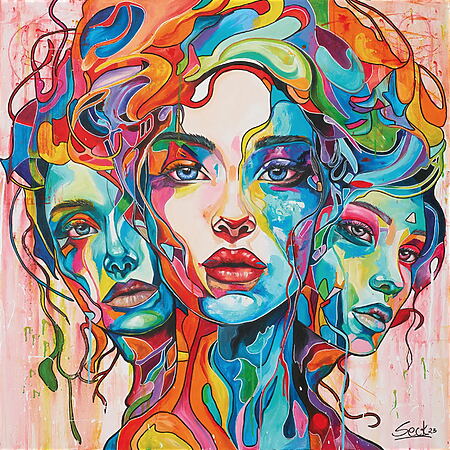Andy Warhol is the artist celebrated as the number one contemporary artist by the renowned "rating agency of the art scene." This top position is not only an expression of his widespread fame but also a reflection of his enormous financial success, which he himself brought about: Warhol was a graphic artist, painter, visual artist, filmmaker, publisher, and a key co-founder of Pop Art .
His work includes graphics and paintings, photographs and films, music productions, objects and books.
Andy Warhol was born in Pittsburgh in 1928, the youngest son of Russian immigrants, and grew up in the area. A serious illness in elementary school left him bedridden for a long time, during which time he developed an interest in art, film, and comics. At 17, Warhol began his four-year course of study (painting, commercial art, and design). After graduating, he was immediately drawn to New York, the center of advertising and the art scene of the time.
There, in the early 1950s, he earned a living from odd jobs, but also laid crucial foundations for his later work: the Russian name Andrew Warhola was shortened, he developed the idea of transferring motifs, and for the first time, he had friends collaborate on his works.

As early as 1952, he had his first significant solo exhibition as a graphic designer in New York , and in 1956, he exhibited at the Museum of Modern Art. By the end of the 1950s, Warhol was already one of the most famous (and most expensive) graphic designers in Manhattan, and now he wanted to make a name for himself as an artist.
He wanted to Canvas art in an innovative way, different from the abstract expressionists of the time (Barnett Newman, Mark Rothko) or the action painting artists like Jackson Pollock .
So he chose his motifs from the pop world and from Hollywood , and comics and cartoons were also processed. However, he soon had to find that this motif world was not a new discovery, artists like Robert Rauschenberg and Roy Lichtenstein had already used it here.
So Warhol drew on images from his surroundings, from advertising, newspapers, and magazines. From these motifs, which were familiar to everyone around him, he had silkscreen prints made and created the well-known works with their numerous serial repetitions.
With an everyday motif, Warhol also reopened in 1962 at his first solo exhibition as an artist, the presentation of Campell's Soup Cans . This was followed by the world -famous picture of Marilyn Monroe, which Warhol processed in several color variations, in the same way, many works were created with Elvis, Liz Taylor and James Dean as a motif.
In all these images, Warhol consciously drew on originals that he further developed. He saw himself less as an art producer than as a replicator of existing works of art. Warhol's artistic work consisted of designing the found motifs according to a specific concept, based on his phenomenal sense for effects, which he had acquired as a commercial artist.
In the period that followed, Warhol was increasingly provided with templates from popular culture, even with repulsive motifs such as photos of car accidents and suicide.
Art criticism could not escape the aesthetic charm of the pictures, which, even due to the serial repetitions, did not put the motif, but the design in the foreground. In these works you could see an answer to the manipulations with which the modern mass media increasingly sought to influence the viewer.
The shrill coloring and the deliberately careless mission of the colors also created an unknown attractive look that reminded of a film strip and fascinated the contemporaries. It only lasted until 1965 until Warhol's pictures were celebrated as a sensations on the entire art market.
Andy Warhol had done it, the screen printing work was increasingly manufactured by assistants. Warhol subsequently devoted himself to numerous art projects and was an enthusiastic visitor to the New York VIP party scene. Critics accuse him of producing always uninhibited commerce until his death in 1987, while the Aficionados saw every activity of the "Sphinx without secret" (Warhol characterization of the writer Truman Capote) as art.
In the following video you can see a 50-minute documentary (in English) about Andy Warhol with a large selection of his works:


















